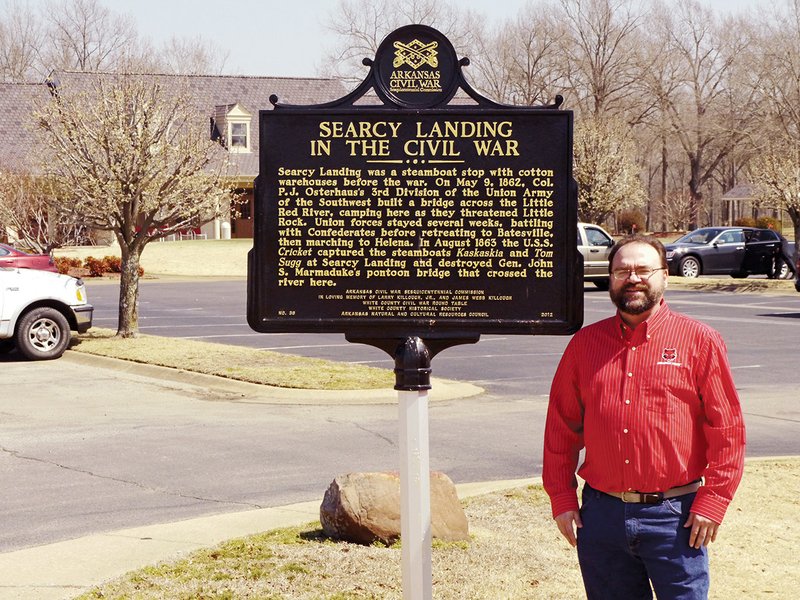Local history buffs don’t have to take an expensive tour to see points of interest from the Civil War. White County is home to six metal plaques commemorating significant places and people from the War Between the States.
That number far surpasses the goal of the Arkansas Civil War Sesquicentennial Historical Marker Program, which encouraged sponsorship of one metal marker in each of Arkansas’ 75 counties to pay homage to the relevance of Arkansas in the Civil War on the 150th anniversary of the U.S. Civil War. Erecting the markers in White County has been a joint effort of the White County Historical Society, the Civil War Round Table and private donations, said Scott Akridge, a member of the historical society.
The marker Navel Combat at West Point recognizes the fight that ensued when the Union gunboat Cricket traveled up the Little Red River in pursuit of two Confederate steamboats on Aug. 14, 1863, and were subsequently attacked by 500 Confederate soldiers. The combat led to damage to the town of West Point as the Cricket fired cannon rounds at its Confederate foes. A separate plaque commemorating West Point’s part in the war also stands in the tiny town, Akridge said. He explained that at the time of the war, West Point was the second-largest town in White County and was a major steamboat port.
A marker at Searcy’s River Oaks Golf Course, Searcy Landing in the Civil War/Guerrilla War on the Little Red, is related to the West Point naval combat. Akridge noted that the steamboats being chased by the Cricket were captured at Searcy Landing, where Union forces also destroyed a pontoon bridge.
“Searcy Landing was a focal point of both armies in White County during the Civil War,” Akridge said. “Thousands of Union soldiers encamped there in 1862; the transport boat capture in 1863 was part of the Union effort to capture Little Rock,” he said.
The Confederates also used the area as a base and crossing point between Union headquarters at Batesville and Little Rock in 1864.
On the outskirts of Searcy, another marker, Action at Whitney Lane, tells the story of how combat on May 19, 1862, between a group of Texas Rangers and 50 local men ended with 22 Union soldiers killed and 33 wounded. The fight persuaded Union Gen. Samuel Curtis to abandon his advance on Little Rock, and the state capital remained in Confederate hands for another year. The marker at Whitney Lane lists the soldiers from both Union and Confederate forces, which is somewhat unusual, Akridge said.
“Because of the way the armies kept reports, we were able to verify the names of the soldiers that were killed and put them on the plaque,” he said. When the plaque was dedicated at Whitney Lane in 2010, one of the descendants of a Union soldier killed in the battle traveled from St. Louis for the ceremony, Akridge said.
Akridge’s interest in the battle at Whitney Lane began when, as a young boy growing up in the neighboring town of Kensett, stories were told about the fight. Later, Akridge and Emmett Powers combined their knowledge and research about Whitney Lane to write the book A Severe and Bloody Fight.
“There was a satisfaction in learning and piecing together what really happened,” he said. The book served as a tool to clarify some of the misconceptions about what occurred at Whitney Lane. For example, tales had abounded about how Union soldiers pillaged the area, when, in fact, Akridge said, the Union forces were running low on supplies and were taking what they needed to survive. No matter the motivation, their actions were not appreciated by residents.
Akridge also recently acquired a letter written in the 1940s chronicling an attempt to have a marker erected commemorating the Battle at Whitney Lane. The letter has been dubbed “the mystery letter.”
The marker Confederate Salt Works Destroyed can be found at the Bald Knob City Hall. At the time of the war, salt was processed from water at a site between what is now Bald Knob and Augusta, and the salt was used to cure meat, Akridge said. The Union Army destroyed the salt works in 1864.
Located at the Gum Springs Fire Department is a marker interpreting the skirmish at Des Arc Bayou. Union forces went on a “search-and-destroy mission” to kill Confederate soldiers on what is now Arkansas 267. The Union plan went awry when Confederates ambushed the Union troops as they slept at 4:30 in the morning, sending the Union soldiers scrambling into the darkness.
A marker honoring Brig. Gen. Dandridge McRae stands in the Oak Grove Cemetery on Moore Street in Searcy. McRae was the only person from White County to attain the rank of general, Akridge said.
All of the plaques marking the people and events that played a significant role in the Civil War were sponsored by residents and organizations. Each marker cost $2,000 to $2,500, with the state supplying $1,000 and contributions making up the remainder of the expenses.
For more information on Civil War markers in Arkansas, visit arkansascivilwar150.com.
